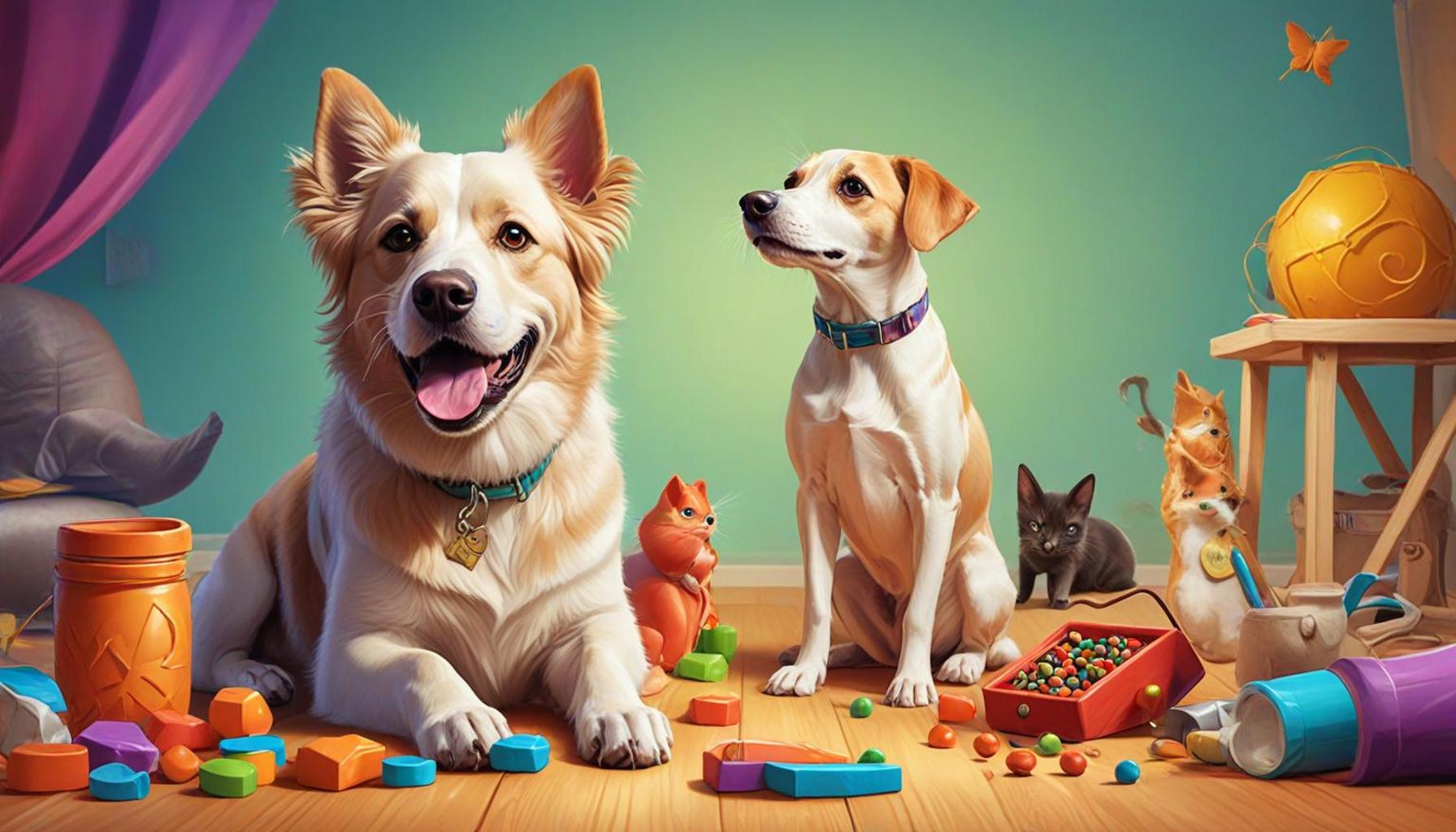Reward Strategies and Their Impact on Pet Training

The Role of Reward Strategies in Effective Pet Training
Pet training transcends the mere act of teaching commands; it encompasses nurturing a bond of trust and mutual understanding between the pet and the owner. One of the most effective techniques in establishing this strong relationship is through reward strategies. These methods not only serve as incentives for pets to learn and exhibit desired behaviors but also strengthen the emotional connection between a pet and its owner. Particularly in Nigeria, where pets are increasingly considered integral members of the family, the application of well-thought-out reward strategies can substantially improve training effectiveness.
Types of Rewards
One of the fundamental elements of reward strategies is the variety of types of rewards that can be utilized. These may include:
- Treats: Delicious snacks specifically designed for pets can be very motivating. For example, using locally sourced treats such as liver or fish, which many dogs in Nigeria find irresistible, can enhance their eagerness to learn.
- Praise: Positive reinforcement through verbal affirmations like “Good boy!” or a gentle pat on the head can encourage repetition of good behavior. This form of non-material reward is essential in developing trust.
- Playtime: Engaging your pet in their favorite game following a successful training session can be a highly effective reward. Fetch, tug-of-war, or chase can reinforce the bond between owner and pet.
- Favorite Toys: Allowing access to a beloved toy after an accomplished task can motivate pets to perform well. This tactic is particularly useful for younger pets who have very high energy levels.
The Importance of Timing
Another critical aspect of reward strategies is the timing of reinforcement. Offering an immediate reward after a desired action solidifies the association between the behavior and the reward. This prompt response helps the pet understand which behavior was appropriate, making the learning process faster and more effective. For example, if a dog sits on command and receives a treat within seconds, it will likely repeat the behavior in the future.
Consistency Drives Success
To maintain effective training, consistency in rewards is vital. A structured approach to rewarding behaviors ensures pets are clear about what is expected from them. If a treat is always given for sitting but not for lying down, the pet can become confused. Maintaining a consistent reward system aids in reinforcing learned behaviors and enhances long-term retention of commands.
Cultural Significance of Rewards
Incorporating traditional Nigerian treats into training not only offers motivation but also fosters a unique bond between pets and their owners that is steeped in cultural significance. Foods like meat pies or specially prepared boiled chicken can serve as special training rewards that cater to local customs and tastes, making the interaction more meaningful.

Tailored Reward Strategies
The journey of understanding reward strategies extends to tailoring them to individual pets. Each pet has its own unique preferences, and experimenting with different types of rewards can lead to surprising discoveries. By observing what excites or motivates each pet, trainers can unlock remarkable potential in their training routines. Whether it’s adjusting treats based on dietary needs or introducing new toys, personalizing reward strategies can lead to quicker and more effective learning experiences.
As pet owners in Nigeria embrace these reward strategies, the potential to cultivate a well-behaved pet while enhancing the companionship becomes boundless, paving the way for a joyful and harmonious living environment.
ADDITIONAL INSIGHTS: Expand your understanding here
Understanding the Mechanics of Reward Strategies
Reward strategies in pet training act as the driving force that shapes behaviors and cultivates learning. The essence of these strategies lies not only in the type of reward offered but also in the psychological response they elicit from the pet. To fully grasp the nuances of how reward strategies impact pet training, it is essential to examine several crucial components, including motivation, timing, and adaptability.
Motivation through Rewards
The cornerstone of any effective reward strategy is its ability to motivate pets to engage in desired behaviors. Different pets respond to various stimuli, underscoring the importance of identifying what truly excites or motivates them. Some common motivators include:
- Food Rewards: High-value treats, particularly those sourced locally, can significantly enhance a pet’s desire to learn. In Nigeria, foods such as small pieces of cooked chicken or even special dog biscuits sold in markets can work wonders in motivating canines during training sessions.
- Affection: Many pets are motivated by affection. Compliments, gentle strokes, or loving cuddles can prompt them to repeat desirable behaviors.
- Environmental Enrichment: Incorporating elements from their environment, such as playing with other pets or allowing them to explore a new space, can serve as a reward that enriches their learning experience.
The Psychological Effects of Rewards
Understanding pet psychology is fundamental in developing effective reward strategies. When a pet receives a reward, it triggers a biochemical response in their brain, reinforcing positive behaviors and making them more likely to be repeated. The dopamine release associated with rewards not only makes the pet feel good but also solidifies the connection between the behavior and the resulting positive experience. This neurochemical response is a compelling reason why timely and appropriate rewards are critical during the training process.
Adapting Reward Strategies
Reward strategies aren’t one-size-fits-all; fostering effective training requires pet owners to continually assess and adapt their tactics. This might involve changing the type of reward based on the pet’s current mood, preferences, or even their stage of life. For example, an energetic puppy might respond better to playtime as a reward, while an older dog may appreciate a relaxing cuddle session. Regularly observing a pet’s reactions to different types of rewards can lead to enhanced training outcomes. Adapting these strategies not only aids in keeping the training sessions engaging but also helps in building a deeper connection and understanding between pet and owner.
As pet training evolves, considering the intricate dynamics of motivation and psychological feedback becomes paramount. By focusing on tailored reward strategies that resonate with the pet’s individual needs, owners in Nigeria can create a more enriching training environment that not only enhances learning but also fortifies the bond they share with their beloved pets.
| Advantages of Reward Strategies | Impact on Training Outcomes |
|---|---|
| Increased Motivation | Using rewards significantly boosts a pet’s motivation to participate in training sessions, fostering a positive learning environment. |
| Strengthened Bond | Effective reward strategies enhance the bond between pet and owner, allowing for a deeper understanding and better communication. |
| Faster Learning | When pets receive rewards, they are likely to learn commands faster, reducing training time significantly. |
| Behavioral Correction | Rewards can be effectively used to correct undesirable behaviors more positively than punishment, promoting a good behavior reinforcement cycle. |
Reward strategies, such as treats, praise, and playtime, not only motivate pets but also create an environment conducive to effective training. These positive reinforcements serve as powerful tools for shaping behavior, enhancing the learning curve significantly. Engaging pets through rewards means they are more likely to repeat desired behaviors, making the training process more efficient. Moreover, as pets associate training with enjoyable experiences, their willingness to participate increases, leading to better overall outcomes. Each strategy must be tailored to the individual pet’s preferences, allowing for a personalized approach to training that maximizes effectiveness and strengthens the human-animal bond. Engage in exploring the various types of rewards and how they can be seamlessly integrated into training routines for optimal results.
LEARN MORE: This related article may interest you
The Role of Consistency and Variety in Reward Strategies
Beyond motivation and psychological effects, consistency and variety in reward strategies are pivotal factors that significantly influence the effectiveness of pet training. By understanding how these elements intertwine, pet owners can enhance their training techniques, making the process more productive and enjoyable for both the pet and the trainer.
Consistency in Rewards
Establishing a consistent reward system is essential for reinforcing desired behaviors. When pets receive praise, treats, or other rewards every time they perform a behavior correctly, they quickly associate the action with a positive outcome. In Nigeria, utilizing a consistent approach to reward strategies can mitigate confusion, especially in young and impressionable pets. For instance, if a dog sits on command, offering a treat each time creates a reliable link in the dog’s mind between the behavior and the reward, streamlining the learning process.
However, owners must also be aware of the balance between consistency and over-reliance on rewards. As pets master certain commands, it may be beneficial to gradually introduce intermittent rewards. This variation helps maintain their engagement and attentiveness during training sessions while ensuring they continue to perform well without always expecting a treat. Research has shown that intermittent reinforcement can lead to stronger behavioral retention, as pets learn to perform actions for intrinsic reasons rather than solely for external rewards.
The Power of Variety in Rewards
Introducing variety in reward strategies is equally important in sustaining a pet’s interest and excitement during training. Pets, like humans, can experience fatigue if they are given the same type of reward repeatedly. By diversifying reward types, trainers can keep pets engaged and motivated. In Nigeria, pet owners can experiment with different forms of rewards:
- Novel Treats: While food rewards are effective, introducing new flavors or textures, such as fish or liver treats, can reignite a pet’s interest.
- Interactive Toys: Some pets thrive on play and stimulation. Offering a new toy as a reward can create enthusiasm and anticipation during training.
- Fun Activities: Rather than just offering food or praise, engaging pets in their favorite games or activities, such as fetch or tug-of-war, can enhance their connection with the training process.
Timing – The Key to Effective Rewards
While motivation, consistency, and variety in rewards are critical, timing plays a particularly crucial role in the success of reward strategies. Immediate reward delivery after a desirable behavior helps strengthen the link in the pet’s mind between the action and the reward. In training environments, especially in areas where distractions are prevalent, swift reinforcement can make a significant difference. For instance, calling a dog to come back and rewarding them right away with a treat when they comply ensures that the association between the command and the positive outcome is clear.
Moreover, using specific cues or markers, such as clickers or verbal cues like “Yes!” before giving the reward can also improve communication between the trainer and the pet. This not only clarifies the action being celebrated but also builds anticipation for what’s to come, further enhancing the training experience.
By focusing on the critical roles of consistency, variety, and timing in reward strategies, pet owners in Nigeria can transform not just their training methods, but also the overall relationship they share with their pets. This multifaceted approach creates a positive learning environment where pets can thrive, nurturing both their intelligence and emotional connection to their owners.
SEE ALSO: Click here to read another article
Conclusion: Maximizing Pet Training through Effective Reward Strategies
In the realm of pet training, the implementation of well-crafted reward strategies serves as a catalyst for successful behavioral outcomes. As explored throughout this article, the interplay between consistency, variety, and timing is pivotal in not only shaping desirable behaviors but also fostering a deeper emotional bond between pets and their owners. For pet owners in Nigeria, adopting a consistent reward system can streamline the learning process for pets, ensuring that each good behavior is met with immediate and gratifying feedback.
Moreover, incorporating a variety of rewards—from novel treats to engaging toys—helps maintain a pet’s enthusiasm for training, preventing monotony and enhancing motivation. As pets learn to associate their actions with positive outcomes, they are more likely to develop intrinsic motivation, further establishing a robust foundation for lifelong learning.
Ultimately, the effectiveness of training is significantly influenced by the timing of rewards, highlighting the importance of immediate reinforcement in securing behavioral links. Utilizing specific markers, such as clickers or verbal praise, augments communication and enriches the overall training experience.
As pet owners adapt these strategies, they not only enhance their pet’s training but also nurture an environment of joy and cooperation. Thus, mastering these reward strategies paves the way for a fulfilling journey of companionship, where both pets and owners flourish together. Embracing these concepts can lead to remarkable transformations in how pets learn and bond, making training an exciting adventure for all involved.


